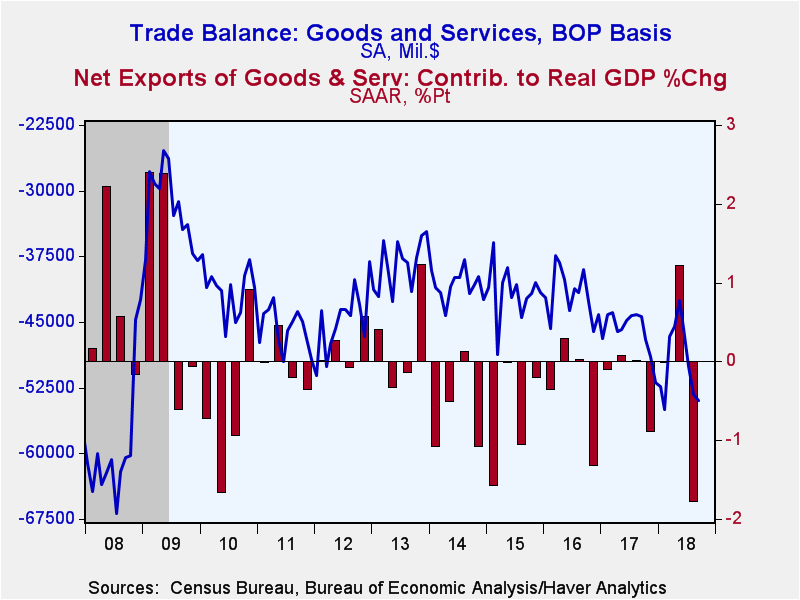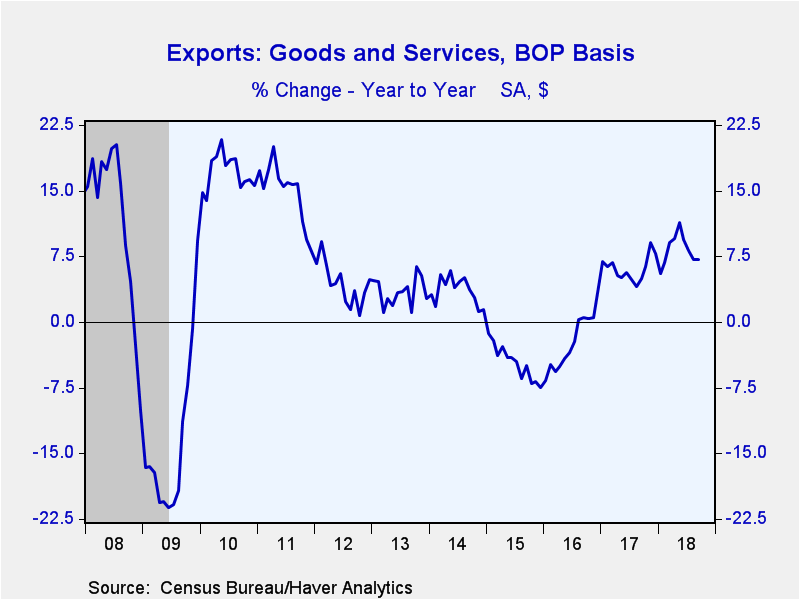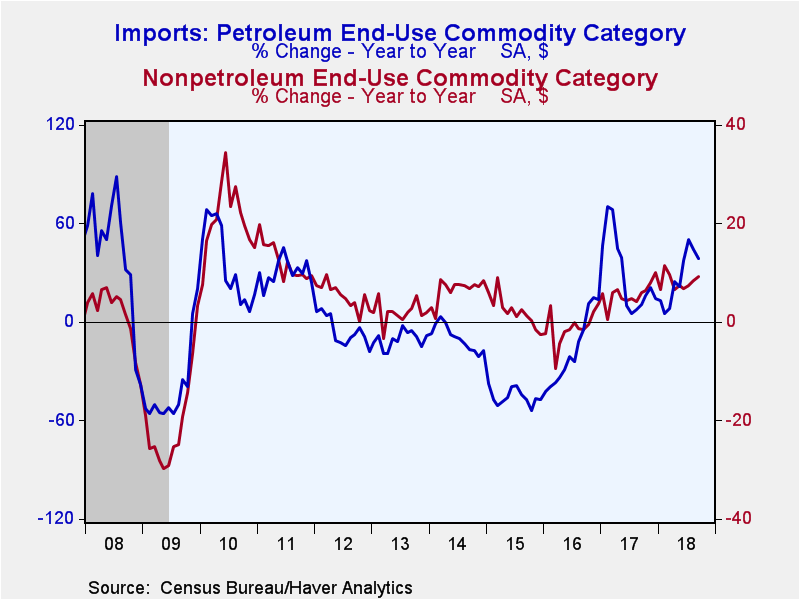 Global| Nov 02 2018
Global| Nov 02 2018U.S. Trade Deficit Increases for Fourth Consecutive Month in September
Summary
The U.S. trade deficit in goods and services widened further to $54.02 billion in September from a slightly upwardly revised $53.31 billion in August. This was the largest deficit since February. A deficit of $53.4 billion had been [...]
The U.S. trade deficit in goods and services widened further to $54.02 billion in September from a slightly upwardly revised $53.31 billion in August. This was the largest deficit since February. A deficit of $53.4 billion had been expected in the Action Economics Forecast Survey. Though exports and imports both increased 1.5% month-on-month (7.2% and 9.8% year-over-year respectively) in August, the trade deficit widened because the U.S. imports 25% more than it exports.
The deficit in goods trade increased to $77.2 billion from $76.6 billion in August. Exports of goods rose 2.1% m/m (8.5% y/y) following three consecutive monthly declines. A 6.3% jump in the volatile industrial supplies – which includes petroleum exports – led the overall gain in exports. Both the quantity and price of oil exports increased. Exports of non-auto capital goods grew 2.3% and autos were up 1.3%. Meanwhile, foods, feeds and beverages exports dropped 8.0%.
Imports of goods rose 1.6% (11.4% y/y) in September, the fifth consecutive monthly gain. Non-auto capital and consumer goods imports grew 4.1% and 3.7% respectively. Meanwhile auto imports weakened 1.9% and foods, feeds and beverages were down 1.3%. Petroleum imports decreased 1.4% predominantly driven by a decline in the quantity of petroleum imports.
The surplus on services trade edged down to $23.2 billion in September from $23.3 billion. Services exports increased 0.4% m/m (4.5% y/y). Imports of services rose 0.8% (2.9% y/y).
The real (inflation-adjusted) goods trade balance widened to $87.0 billion (chain weighted 2012$) in September from $86.3 billion in August. This data is consistent with last week’s third quarter GDP report in which the trade balance subtracted 1.8 percentage points.
The politically sensitive goods trade deficit with China jumped to $37.4 billion (seasonally adjusted) in September. This is the largest deficit recorded outside of the port-strike related $40.5 billion reading in March 2015. U.S. exports to China rebounded 4.4% (-10.9% y/y) after an 11.3% drop in August. Imports jumped 7.8% (12.5% y/y) following a 2.1% decline.
The international trade data as well as oil prices can be found in Haver’s USECON database. Detailed figures on international trade are available in the USINT database. The expectations figures are from the Action Economics Forecast Survey, which is carried in AS1REPNA.
| Foreign Trade in Goods & Services (Current $) | Sep | Aug | Jul | Y/Y | 2017 | 2016 | 2015 |
|---|---|---|---|---|---|---|---|
| U.S. Trade Deficit ($ bil.) | 54.02 | 53.31 | 50.04 | 44.41 (9/17) |
552.28 | 502.00 | 498.53 |
| Exports of Goods & Services (% Chg) | 1.5 | -0.8 | -1.0 | -1.0 | 6.1 | -2.2 | -4.6 |
| Petroleum (% Chg) | -11.5 | 2.6 | 8.5 | 50.9 | 41.2 | -9.6 | -32.5 |
| Imports of Goods & Services (% Chg) | 1.5 | 0.6 | 0.9 | 9.8 | 6.8 | -1.7 | -3.5 |
| Petroleum (% Chg) | -1.4 | 0.6 | 3.8 | 38.7 | 27.2 | -19.5 | -45.5 |
| Nonpetroleum Goods (% Chg) | 2.1 | 0.8 | 0.6 | 9.3 | 5.6 | -1.2 | 2.2 |
Gerald D. Cohen
AuthorMore in Author Profile »Gerald Cohen provides strategic vision and leadership of the translational economic research and policy initiatives at the Kenan Institute of Private Enterprise.
He has worked in both the public and private sectors focusing on the intersection between financial markets and economic fundamentals. He was a Senior Economist at Haver Analytics from January 2019 to February 2021. During the Obama Administration Gerald was Deputy Assistant Secretary for Macroeconomic Analysis at the U.S. Department of Treasury where he helped formulate and evaluate the impact of policy proposals on the U.S. economy. Prior to Treasury, he co-managed a global macro fund at Ziff Brothers Investments.
Gerald holds a bachelor’s of science from the Massachusetts Institute of Technology and a Ph.D. in Economics from Harvard University and is a contributing author to 30-Second Money as well as a co-author of Political Cycles and the Macroeconomy.









